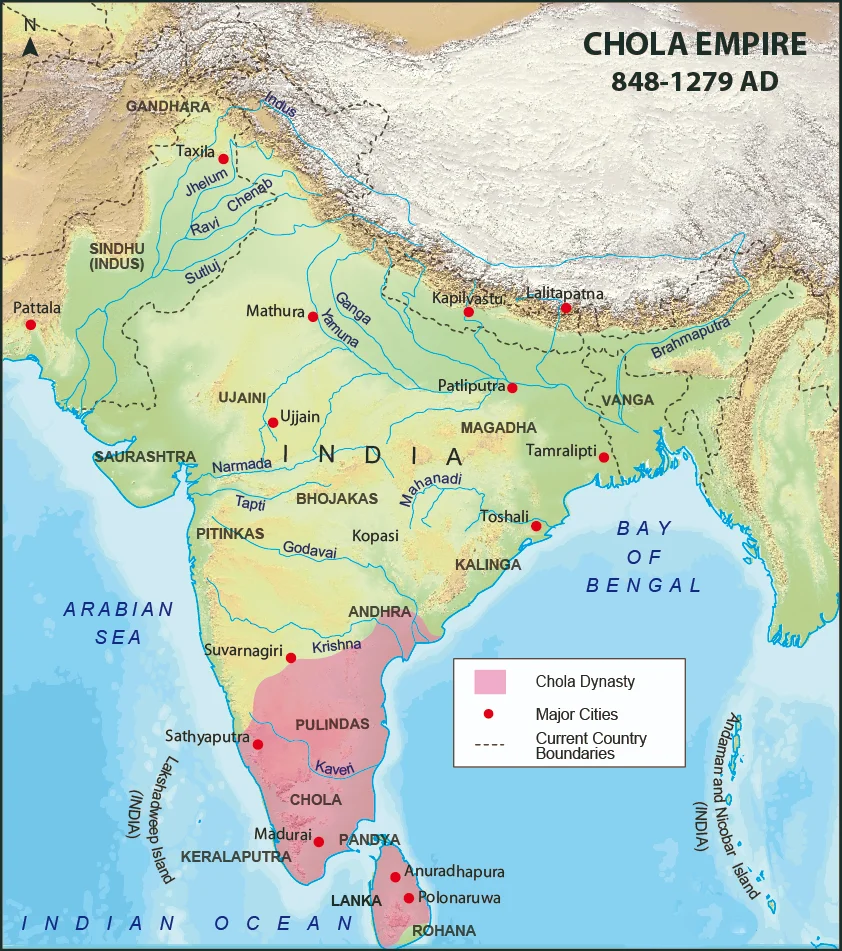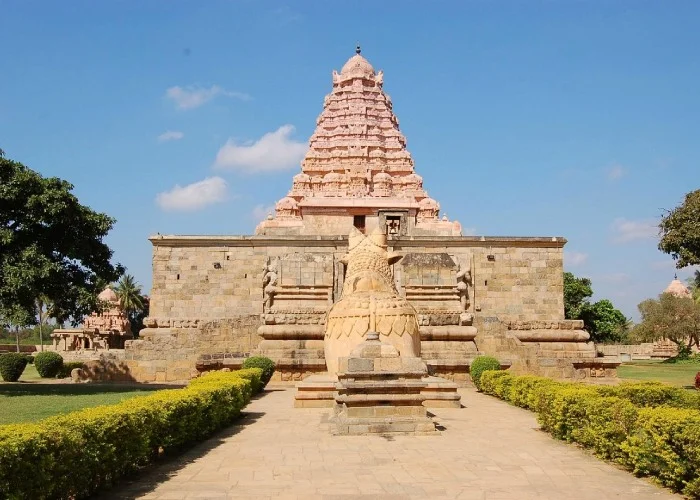1,000 Years of Rajendra Chola I's Maritime Expedition | 29 Jul 2025
For Prelims: Thiruvalangadu Inscription, Battle of Kandalur Salai, Cholas, Pandyas, Cheras, Chalukyas, Nagapattinam, Local Self-Government, Brihadeshwara Temple, Dravidian Temple Architecture, UNESCO, Gangaikonda Cholapuram, Airavateshvara Temple, Dakshina Meru, Mural Paintings, Bharatanatyam, Nataraja Statue
For Mains: Contribution of Chola dynasty in Indian history, Art & Architecture of Chola dynasty.
Why in News?
The Prime Minister visited Gangaikonda Cholapuram in Ariyalur district, Tamil Nadu, during the Aadi Thiruvathirai festival, and the Brihadisvara Temple (UNESCO World Heritage Site).
- He highlighted the Chola Empire’s democratic traditions, and released a commemorative coin marking 1000 years of Rajendra Chola I’s Gangetic expedition.
- The Aadi Thiruvathirai Festival commemorated 1,000 years of Rajendra Chola I's legendary maritime expedition to Southeast Asia and also marked the rich Tamil Shaiva Bhakti tradition.
What are the Key Facts About Rajendra Chola I?
- About: Rajendra Chola I (1014 to 1044 AD), son of Rajaraja Chola I, was one of the greatest rulers of the Chola Empire.
- He was the first Indian king to lead overseas military expeditions, extending Chola influence across South and Southeast Asia.
- Titles and Legacy: He assumed titles like Gangaikonda Cholan (after defeating the Palas in Bengal) and Kadaram Kondan (after naval victories in the Srivijaya Empire), Pandita Cholan, and Mudikondan.
- Founded a new capital, Gangaikondacholapuram, to commemorate his northern conquests.
- Built Brihadisvara Temple (Gangaikondacholeeswaram) and Chola Gangam Lake (Ponneri) in present-day Ariyalur, Tamil Nadu.
- Military and Naval Prowess: He reasserted control over Chera and Pandya regions; defeated Jayasimha II of Western Chalukyas, Tungabhadra River became the northern frontier.
- His conquests included Sri Lanka, Maldives, Nicobar, Lakshadweep, Kedah, Tambralinga, and Burma, establishing one of India's earliest blue-water navies.
- Trade, Culture, & Administration: Under his rule, Tamil merchant guilds like Manigramam and Ayyavole thrived, fostering trade and cultural exchange with China and Southeast Asia.
- Promoted Shaivism, patronized Chidambaram’s Nataraja Temple, yet maintained religious tolerance toward Vaishnavism and Buddhism.
Chola Dynasty
- One of the three major Tamil dynasties, alongside Cheras and Pandyas, and among the longest-ruling powers in South India.
- Founded by Vijayalaya Chola in the 9th century AD after defeating the Pallavas.
- The empire expanded across South India, Sri Lanka, and parts of Southeast Asia.
- It reached its peak under Rajaraja Chola I and Rajendra Chola I, known for military conquests and administrative excellence.
- Declined with the resurgence of the Pandyas in the 13th century.
- Key Rulers:
- Vijayalaya Chola: Founder, captured Tanjore.
- Aditya Chola I: Defeated Pallavas, annexed Tondaimandalam.
- Parantaka Chola I: Won battles, forged alliances, but suffered defeat at Takkolam.
- Rajaraja Chola I: Built Brihadeeswara Temple, expanded empire.
- Rajendra Chola I: Continued Rajaraja’s legacy, including naval conquests.
- Kulothunga Chola I: Strengthened administration, promoted trade.
- Rajaraja Chola II: Marked the decline of the Chola Empire.
Read More:
What are the Key Features of Chola Administration & Architecture?
Chola Administration
- Centralised Monarchy with Decentralised Governance: The Chola Empire maintained a centralised monarchy, headed by king and supported by a structured ministerial council, with high officials called Peruntaram and lower ones as Siruntaram.
- Capitals like Tanjore and Gangaikondacholapuram symbolised imperial power, and royal tours helped improve governance.
- Provincial and Local Administration: The empire was divided into Mandalams (provinces), Valanadus, Nadus and Urs (villages).
- Towns or Nagarams were run by merchant guilds (Nagarattar), while Nattar governed Nadus and Periyanattar managed Valanadus. Local self-governance was strong, especially at the village level.
- Village Self-Governance & Early Democratic Practices: Village assemblies- Sabhas (Brahmin villages) and Urs (non-Brahmin villages) had real power over revenue, justice, irrigation, and temples.
- A unique Kudavolai system (palm-leaf ballot), where the names of eligible candidates were placed in a pot and drawn by a child in public ensured transparent village elections.
- Eligibility to contest included owning tax-paying land (≥ ¼ veli), being aged 30–70, local residency, and knowledge of Vedas or administration.
- Disqualifications included alcoholism, crime, unpaid debts, kinship with officials, or prior misconduct.
- Accountability was ensured through annual audits.
- However, the system excluded women, landless labourers, and lower castes, reflecting its hierarchical and non-inclusive nature.
- Revenue Administration: The revenue system was managed by a department called Puravuvarithinaikkalam, with land surveys and classification.
- Temple lands and Ur Nattam (residential zones) were tax-free. The main source of revenue included land revenue (1/6th of produce), paid in cash or kind.
- Other taxes included tolls, customs, profession tax, marriage dues, salt pans, etc. Kulottunga I abolished tolls and earned the title "Sungam Tavirtta Cholan".
- Expenditure included royal court, army, irrigation, roads, canals.
- Military Administration: Cholas maintained a strong 4-fold army: Infantry, Cavalry, Elephants, Navy and key forces included Kaikkolaperumpadai (royal army) and Velaikkarar (bodyguards).
- Training was held at Kadagams (cantonments). The navy was powerful, securing Bay of Bengal dominance and influence in Sri Lanka and Southeast Asia.
- Trade and Economic Administration: Internal trade was organized via powerful merchant guilds like Manigramam, Ayyavole, and Nanadesis.
- Urban merchant bodies (Nagarams) played a role in civic and economic governance.
- Chola ports like Puhar supported flourishing maritime trade with West Asia, China, and Southeast Asia.
- Exports included textiles, spices, gems and imports included luxury items, horses. Urban guilds (Nagarams) aided civic governance.
Chola Art and Architecture:
- The Dravidian style of temple architecture reached its peak under the Cholas.
- The defining feature is the Vimana (tower over the sanctum). Temples typically included components like vimana, ardhamandapa, mahamandapa, and Nandimandapa (pavilion for Nandi).
- Early examples include temples at Narthamalai, Kodumbalur, and Srinivasanallur. Major temples like the Brihadisvara Temple in Thanjavur (by Rajaraja I), Gangaikondacholapuram (by Rajendra I), Airavatesvara Temple (Darasuram), and Kampaharesvara Temple (Tribhuvanam) show their architectural brilliance.
- Chola temples like Tanjore and Gangaikondacholapuram are adorned with large, finely executed sculptures.
- The Chola bronze sculptures, especially the image of Nataraja (dancing Shiva), are globally renowned for their aesthetic beauty, grace, and craftsmanship.
- Chola paintings were found on temple walls at Narthamalai and Tanjore, reflecting both religious and secular themes.
Brihadeeswarar Temple (Gangaikonda Cholapuram Temple) Ariyalur
- Built by Rajendra Chola I (1014 to 1044 AD)to commemorate his Gangetic expedition, this temple marked the shift of Chola capital from Thanjavur to Gangaikonda Cholapuram, which remained the imperial seat until 1279 AD.
- Dedicated to Lord Shiva, the temple (Gangaikondacholisvarar) reflects refined Dravidian architecture, surpassing even the earlier Brihadisvara Temple built by his father Rajaraja Chola I, symbolising both military glory and religious devotion.
- The annual Aadi Thiruvathirai festival celebrates Rajendra’s birth star (Thiruvadhirai) with Therukoothu performances and ceremonial offerings, reflecting the dynasty’s cultural legacy.
- Supported by inscriptions from 1027 & 1068 AD and the Esalam copper plates (1036 AD), the temple received sustained royal patronage under Chola rulers like Virarajendra.
- It was declared a UNESCO World Heritage Site in 2004, along with the Airavatesvara Temple at Darasuram. Thanjavur temple was earlier included in 1987, all together forming the Great Living Chola Temples.
|
Drishti Mains Question: Examine the architectural contributions of the Chola dynasty, particularly the Dravidian temple style. How did these architectural achievements reflect the empire’s cultural and religious values? |
UPSC Civil Services Examination Previous Year Question (PYQ)
Prelims
Q. The Nagara, the Dravida and the Vesara are the (2012)
(a) three main racial groups of the Indian subcontinent
(b) three main linguistic divisions into which the languages of India can be classified
(c) three main styles of Indian temple architecture
(d) three main musical Gharanas prevalent in India
Ans: (c)
Mains
Q: (a) Discuss the Tandava dance as recorded in the early Indian inscriptions.
(b) Chola architecture represents a high watermark in the evolution of temple architecture. Discuss. (2013)
Q. Indian philosophy and tradition played a significant role in conceiving and shaping the monuments and their art in India. Discuss. (2020)


